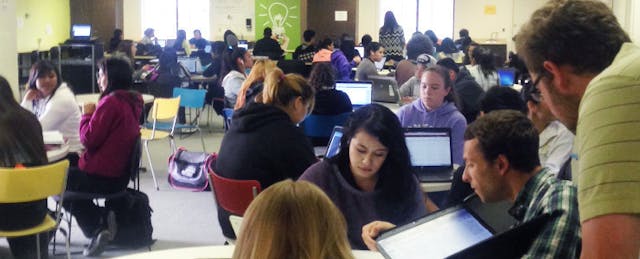Fail quickly. Fix quicker. If you’re an entrepreneur that mantra might sounds familiar, if you’re a teacher, not quite so. But just as many companies in Silicon Valley have been inspired by the book, The Lean Startup, Summit Public Schools, which serve 400 students in grades 9th-10th grade in the San Jose area, is figuring out how to adopt and adapt this concept from the business environment to offer better learning experiences for their students. How are they doing this? With data, data, data and… data!
Summit's MVP
Summit's methodology is simple: every little change made or product created (their very own "Minimum Viable Product") by either teachers or administrators goes into students' hands as soon as possible. Then, educators measure a kid’s development before, during and after implementing an idea, ask for feedback from students and teachers, analyze this information, and--only then--make their next decisions. In this way, Summit educators realize very quickly when an idea is not achieving expected results--when students aren’t connecting with the lessons or even when they are not acquiring skills the activity was designed to.
“We make a change and we measure it. In traditional models, sometimes you know that some kids are going to fail, but you can't do anything to help them,” says Jon Deane, Summit's chief information officer. Summit aims to be different, its teachers say. The lean startup model means Summit puts users (or in its case, students) at the center of design. The approach focuses on "small batches," which in this case means rather than teaching all students the same topics on the same day in the same way, students access materials when appropriate in a variety of different ways in smaller groups. It also puts heavy emphasis on testing and iterating including, for instance, testing and changing even elements such as seating arrangements, assessment systems, optimal learning styles, and physical layouts of the learning space.
Deane disagrees with those who worry about exposing kids to education "experiments": "Our responsibility is to make schools better. We don't have time to waste. Every initiative is good if we can learn from it," he says.
Even so, Summit has not simply transplanted the lean startup model from the corporate world to the classroom.
Start With Users...and Add Data
"It's always important to remember that our 'users' are our students, which can make the innovation process more gradual and as not as quick as compared to other fields and industries," said Diego Arambula, Summit's chief growth and innovation officer. "We want to ensure that our students' learning is not impacted when piloting a Minimum Viable Product. We do that by ensuring that we do more work on the front-end to try to build out a product," he says. Arambula also recognizes that families expect continuity during the course of a school year; changing the learning plan every day might negatively impact a student’s overall experience and learning.
Crucial to Summit's lean-startup approach has been its system of gathering data. The school relies on a homegrown platform, called Activate Instruction which houses playlists and online learning resources, such as Khan Academy. Teachers use their reports as well collect data daily from other two platforms: Naviance (which connects students' academic work with career and college planning) and ShowEvidence (a writing feedback and a performance assessment system).
Summit also employs old-fashioned elbow grease to capture other data. Every day, members of Summit's Information Team manually add data collected during focal groups discussions and other sorts of student feedback.
A Recipe for Decision Making
Pedagogical decisions are made by sharing experiences. Teachers meet weekly as a group in their "Innovation Cycles" and use data to suggest iterations to strengthen (for now) their math programs and discuss solutions for problems students are facing.
Here's how: Once teachers identify a problem, they describe it on a spreadsheet and then follow a four-step solution:
- One or more teachers identify the problem and agree to take responsibility for solving it;
- They brainstorm
- They develop an action plan;
- They choose the metrics for determining success.
For instance, as a part of the blended math program, students spend time every day working in pair or groups on "personalized instruction"-- watching videos or doing problems, specific to their own needs. The problem that arose: The school picks student partners, aiming to pair students who can help each other. Kids, however, say they would prefer to choose their peers themselves.
Instead of engaging in a battle of wills, Summit is using data to decide whether the school or the students should pick the student teams. Teachers are still analyzing data but at least so far the data suggests that student learning (measured by number of assessments passed, project assignments completed and so on), is similar no matter who picks the partners for working through exercises. Students' focus during math class, however, as well as reflections at the end of each math class, are stronger when the school (not friends) pick the partners.
Adapting a model from the business world to try to stimulate innovation in a public system is the way Summit is trying to give students from poor families the opportunity to make it to a four-year university, say Summit leaders. If it works, Summit should have some hefty evidence in a few years' time to show that "The Lean Startup" approach "really pushes learning as much as you can as quickly as you can..(and that)..schools can and should integrate it into their framework," says Arambula. He adds: "Students expect and deserve a great learning experience every period of every day."


